How to teach a young introvert
By Kate Torgovnick on September 10, 2014 in TED-Ed Lessons
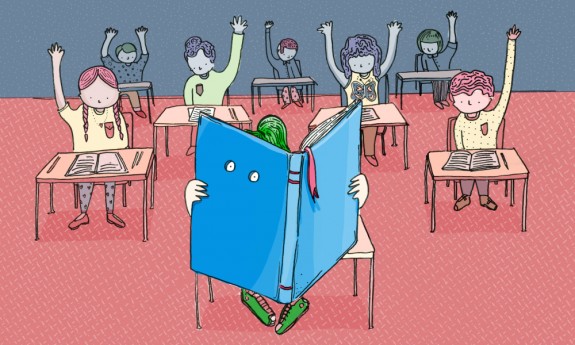
Susan Cain sticks up for the introverts of the world. In the U.S., where one third to one half the population identifies as introverts, that means sticking up for a lot of people. Some of them might be data engineers overwhelmed by the noise of an open-floor-plan office. Others might be lawyers turning 30, whose friends shame them for not wanting a big birthday bash. But Cain particularly feels for one group of introverts: the quiet kids in a classroom.
Cain remembers a childhood full of moments when she was urged by teachers and peers to be more outgoing and social — when that simply wasn’t in her nature. Our most important institutions, like schools and workplaces, are designed for extroverts, says Cain in her TED Talk. [Watch: The power of introverts.] “Nowadays, your typical classroom has pods of desks, and kids are working on countless group assignments.” Yet if up to half the population has introvert tendencies, why is it that kids who prefer to go off by themselves or to work alone are seen as outliers?
We gave Cain a call to talk about how schools, both right now and far off in the future, could better care for the needs of introverted students. Below, an edited transcript of that conversation, with some very surprising answers. Could we rethink the chaotic school cafeteria? How about recess? How about the very definition of “class participation?” Cain offers bold ideas in these areas and more.
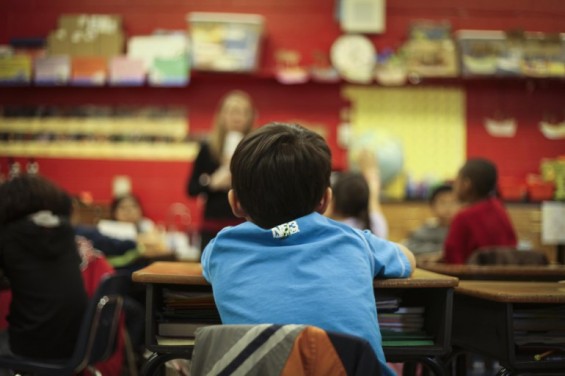
Photo by Tom Woodward/Flickr.
What kind of response did you get to the part of your TED Talk about the education system and how it isn’t optimized for introverts?
I’ve heard from so many teachers and school administrators and parents and students about the problems that they feel are embedded in the system. I’ve heard from students feeling that they are unfairly docked for not meeting current standards of class participation. I’ve heard from teachers who now, in many cases, are required to make a majority of their lessons centered on group work. Even when the teachers feel that’s not a good idea, they have to do it, because the teachers themselves are evaluated on that basis. They don’t have the wiggle room to modify it, even though they think they should. Overall, I’ve seen firsthand in the wake of my TED Talk that there’s such an enormous need for parents and teachers to better understand how to love and cultivate the introverted kid.
What can be done in the short term to help teachers better understand how to do that?
I believe that we need to do general teacher training to just make them aware of what makes a student an introvert, what that means, and how best to cultivate the talent of those students. To raise awareness of what an extroverted act it is in the first place to go to school. All day long, you are in a classroom full of people with constant stimulation. Even for introverted kids who really like school, it’s still a very overstimulating experience.
In general, teachers should avoid setting social standards for what is normal. There’s research that shows that if a student has no friends at all — zero friends — that is problematic and should be addressed. But a student who has one or two or three friends, and prefers to go deep with their friendships instead of being one of a big gang, there’s nothing wrong with that at all, in terms of it being a predictor for adulthood. That style of socializing is perfectly fine. So we should identify problems when they are there — like a student who would really love to make friends but doesn’t know how. But at the same time, we shouldn’t make problems when they aren’t there by saying, “You should be more social.” If the kid is perfectly happy the way they are, they need to get the message that the way they are is cool.
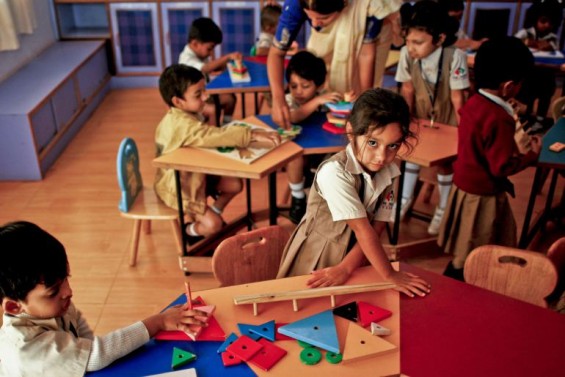
Photo by lecercle/Flickr.
One thing I think that educators should bear in mind: we allow adults all kinds of flexibility in terms of what kind of social life they want. Adults who have two or three friends, no one thinks twice about it. But we don’t allow children the same degree of flexibility. I often ask people to imagine their next big, milestone birthday and to think how they would want to celebrate it. Some people want to celebrate with a big bash full of friends, and other people would rather just go out with family or a couple of close friends. But think about what we expect children to do for their birthday parties. We expect them to invite the whole class, and make it this big, uproarious affair. I get letters from parents all the time, saying, “We invited the whole class over for the birthday, and my child seemed happy for the first 15 minutes, and then she went to her room and wouldn’t come out.” What I’d say is: celebrate the way the kid wants to celebrate. Don’t give the kid the idea that there’s only one way to do it.
What are some small changes that teachers can make in the classroom right now that might make a big difference for kids who are introverts?
Number one would be to make sure to build quiet time into the school day, especially when kids are younger. Have 15 minutes set aside every day where the students just read. Make sure that the classroom design accommodates nooks and crannies so you’re not just reading within groups of people, but you can go and sit on a sofa in the classroom and curl up with your book. When I was researching Quiet, I traveled around and sat in as a fly-on-the-wall in all kinds of classrooms, and many already do this — but not all of them. That would be one easy thing.
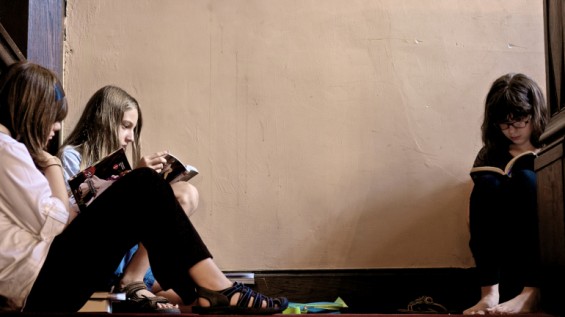
Photo by Greg Williams/Flickr.
Another would be reforming recess. Teachers should think about providing alternatives to recess, which for many students is unnecessarily chaotic and not that interesting. Open up a classroom and let students sit and play board games in small groups, or read a book, or just hang out and chill. The notion that all students should restore themselves by running out into a big, noisy yard is very limiting. Some will like it, some won’t. Some will like it on some days, but would prefer an alternative on other days.
Interesting. So the theme seems to be giving students more options.
Yeah, the idea is just to maximize choice. All the suggestions that I’m giving are along those lines of providing lots of different alternatives for how you get your learning and how you get your restorative time. Let it be more of a pick-and-choose situation instead of it being, “Oh, let’s do it this way.” There’s a well-known study in psychology by a guy named Russell Geen. He gave learning tasks to kids to solve, with varying levels of background noise. He found that the extroverts did best when the noise was louder, and the introverts did best when the noise was softer. If you take that research and apply it to the classroom, it’s crying out for a solution that is less one-size-fits-all — and that allows students to pick the amount of stimulation that is right for them in that moment.
How can teachers make introverted students feel more comfortable when class is in session?
I’d say: less group work in general. Teachers should really mix it up fairly between individual work, group work, and have students do more work in pairs, which is a way that both introverts and extroverts can thrive. There’s one technique that a lot educators will know of already, but should be reminded of: it’s called “think-pair-share.” What you do is ask a question, like “Why did Romeo do what he did?” or “Why did Juliet react the way she did?” and then the teacher thinks about it, and students sit by themselves for a minute or two and they think too. Then they pair up, and discuss their thoughts with their partner. The share part is when they share their thoughts with the group. A lot of students who might be reticent at first will feel emboldened by having first discussed it with a partner.
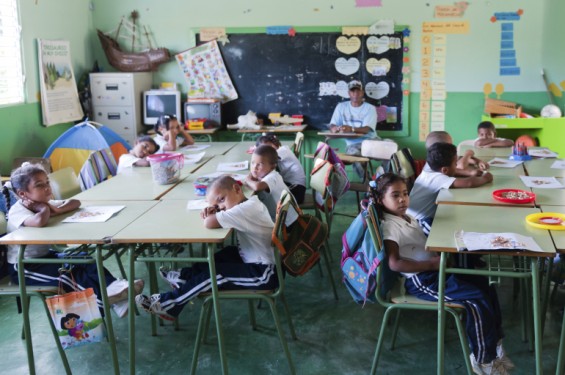
Photo via iStock.
I’d like to challenge teachers to rethink what they mean by class participation and start thinking of it as classroom engagement instead. Participation ends up rewarding quantity, so you get kids raising their hands for the sake of talking, and that’s not really in anybody’s interest. But engagement recognizes that there are a lot of different ways to engage with the material and with your peers. If you think more broadly about it, a student who’s a good listener or who gives one really great, reflective comment is just as valued as the one who’s always raising their hand.
By the way, Greenwich Academy in Connecticut has adopted a lot of these ideas and has really been using them to great effect.
Was that jumpstarted by your talk and book?
Yes. Their teacher reading assignment over one summer was to read Quiet. They also had a group of students who embraced it and started really getting their peers and teachers to address it. They started a little movement within the school.
In May, I talked to the TED Blog about our whole Quiet Revolution. One of the segments that we are going to be tackling is education, because the need is so great. This is the area that is closest to my heart. With our Quiet Revolution, we plan to be doing versions of this with schools across the world — we just need to build out the resources for it. We’re just at the beginning, but our intention is to partner with private and public schools all over the U.S., and ultimately globally, to really make sure that everything I’ve just been talking about can actually happen. We’re looking for the right leader for that right now. Once we have the right leader, I think it will move at the speed of light, because there is so much groundwork in place already. So watch this space. We’re trying to create something that will really give schools the tools that they need.
Now, forget school in the form we know it. If you were designing schools of the future, what would they look like?
I really love the whole “flipped classroom” — Salman Khan’s model, where students do a lot of the hard work on their own the night before, and then come in and have the opportunity to engage one-on-one or in small groups with a teacher to resolve the remaining questions that they have. I think that’s really key for all students. The best way to learn, for sure.
I also think we need to rethink classroom design. It’s definitely integrating way more nooks and crannies and alternative sorts of spaces into our classrooms, but also rethinking our school designs in general. We should be getting away from school design that has students jostling together in one gigantic mass of humanity. There are a lot of students who just don’t thrive like that.
So instead of crowded halls, a design that channels students into different spaces?
Yeah. I’m imagining spaces that are more flexible so at any given moment, you can choose: Do I want to be in a solo space? Do I want to be in a small group space? Do I want to be in a more crowded, lively space? A design that really takes into account the fact that all of us toggle back and forth in our days between wanting each of those three kinds of spaces. Right now, our schools are designed with a kind of monolithic sense of space.
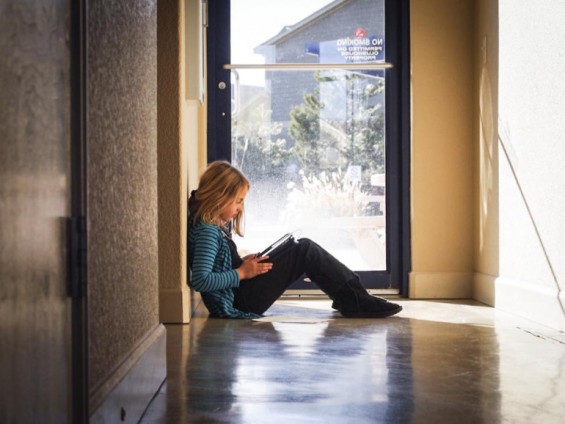
Photo by Lexie Flickinger/Flickr.
How will the curriculum in schools of the future vary from what we see now?
I think the future of education will take into account the research of Anders Ericsson, who invented the concept of “deliberate practice.” He’s a psychologist, and he studied what makes people into really expert, superstar performers — whether it’s in tennis or chess or math. He found that for most people, it’s not a question of having superior talent, but rather a question of having engaged in many, many hours of really concentrated, deliberate practice at the craft that they wanted to master. He says that the key to deliberate practice is that you shouldn’t be doing it in a group where you’re going to be spending too much of your time working on stuff that’s either too hard for you, too easy for you, or not interesting to you. You should be working alone or one-on-one with someone who can coach you along, and answer your questions at the right time. That whole body of work — and it’s pretty extensive right now — really needs to be integrated into the curriculum. That’s one of the reasons I love the flipped classroom idea, because I think it’s heading in that direction.
What kinds of differences would you imagine in how teachers are trained and evaluated?
In terms of teacher training — and I should say, I’m not an educator per se, so I am speaking from my specific corner on this — I think we need way more instruction in knowledge of temperament. There’s a lot of attention in education paid to difference in learning style, and I think not enough understanding of differences of temperament and how that shapes who children are and how they learn and socialize. In terms of how teachers are evaluated, we need to give them way more freedom to design curricula they think will work for their students. Earlier, I was telling you how many teachers tell me that they don’t want to do so much group work, but have no choice. Gosh, that really needs to change.
What kind of social activities are not part of the school day now that could be in the future?
Small-scale socializing. Socializing in pairs and small groups. If you look at your typical school cafeteria, it is set up with the expectation that the students will eat lunch at gigantic tables full of kids. Why? A lot of us would much prefer to socialize with one or two people at a time. So we should have small tables too. I think playgrounds could be designed to encourage more one-on-one or small group play as well. All the social structures should keep that modus operandi in mind.
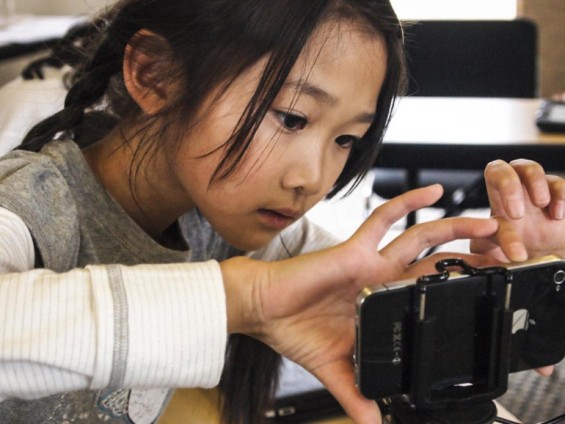
Photo by Lexie Flickinger/Flickr.
Let’s talk about technology. How could technology be integrated into the classroom of the future to give more options, and be there in positive ways for students who are introverts?
I know from talking to educators that there are already tools that can be incredibly helpful — tools that allow students to participate through their electronic devices as opposed to raising their hand. Apps that allow students to contribute to class discussions, sometimes anonymously and sometimes not. Even if it’s not anonymous, the fact that a student is participating in a class discussion or a class blog online removes some of their own psychological barriers to participation. The same kid who might not raise their hand in class might write something really interesting into some kind of classroom app or blog. Then other students see their ideas, and they start talking about it in real life. It’s a bridge to participation.
I think we’ll move toward anything that encourages student participation through an online medium. It could be for student artists or student writers, for example — giving them opportunities to contribute to a class blog or something where their classmates will get to see their hearts and minds in this other forum. I think that really opens things up.
Featured illustration by Dawn Kim.
This piece originally ran on ideas.ted.com as part of their ‘Questions worth asking: What makes a good education?’ series. Check out some of these other pieces from that series:
- Math 101: A Reading list for lifelong learners
- There’s no app for good teaching
- 11 must-see TED-Ed Lessons